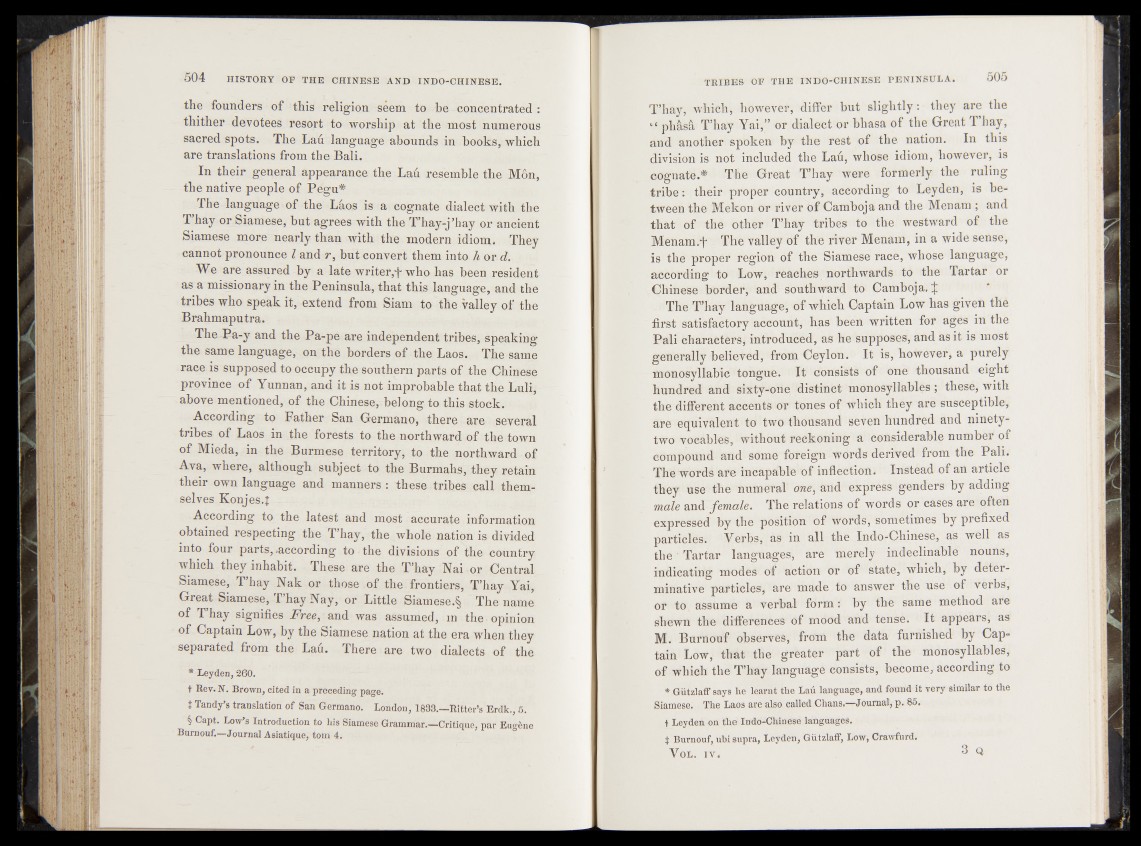
Iho founders of »this religion seem to be - concentrated :
thither devotees resort to worship at the most numerous
sacred.spots. The Laó -language abounds in books,;which
are translations from the Bali.
In their general appearance the Lau resemble the Môn,
the native people of Pdgu*
The language * of the Laos is a cognate dialect with the
T hay orSiames©,- but agrees with the T’hay-j’hay or an ci eût
Siamese more nearly than with the modern idiom* They
cannot pronounce l and r, but convert them into h or. <2. £
We are assured by a late writer,f who has been resident
as a missionary in the Peninsula, that this language, and the
tribes who speak it, extend from Siam to the valley- oiffhe
Brahmaputra.
The-Ea-y and the Pa-pe are independent tribes, speaking
the same language, on the borders of . the Laos. The same
race: is supposed to occupy the southern parts of the';Chiij©se
province of Yunnan, and it is not improbable that thé. Lulir
above mentioned, of the Chinese, belong, to this stock.
According to Father San Germano, there* are several
tribes of Laos in the forests to the northward o f the-town
of Mieda, in the Burmese territory, to the northward of
Ava, where, although subjech to the Burmahs, they retain
their own language and manners: these-tribes çallÿhem-
selves Konje&4 -
According to the latest and most accurate information
obtained respecting the T’hay, the .whoM nation is divided
into four parts, according to * the divisions of the country
which-they inhabit. These are the T’hay Nai -or Central
Siamese, T’hay Nakor those .of the frontiers, T’hay Yai,
Great - Siamese, T’hay N ay, or Little Siamese .§ The name
of T’hay signifies Free, ■ and was assumed, in;the• opinion
of Captain Low, by the Siamese nation at the era when they
separated from the Laû. There are two dialects of the
*=Leyden, 200.
t Rev. N. Brown, cited in a prëceding page.
t Tandy’s translation of San Germano. London, 1833.—-Ritter’s Erdk., 6.
§ Capt. Low’s Introduction to his Siamese Grammar.—Critique, par Eugène
Burnouf.—Journal Asiatique, tom 4.
T’hay, which, howev©#, differ but slightly: - they are the
“ pfallfi; T’h ^BY ^ ” ot daaleet^r bbasa of the Great T’hay,
and another »spbken by the rest of the nation. In this
division is not included the Lafi, whose idiom, however, is
Gtfgnate.* T’bay -were - fotitteily. ths ruling
tribe: thUiS proper country, according to Leyden, is between
the Mekon or river bf Camboja and the Menam ; and
that of the other T’hay tribes to -the westward of the
Menam/f The valteyef the river Menam, in a wide sense,
isMrhd1-proper region of the Siamese race, whose language,
according to Low, reaches, northwards to the Tartar or
Chinese border, and southward to Camboja. tjn
The Thay language, of which Captain Low has given the
first satisfactory account,- “has been written for ages in the
Pali characters, introduced, as he supposes, and as it is most
generally helieted, from Ceylon. It is, however, a purely
monosyllabic tongue. It consists of one thousand eight
hundred and sixty-ohe ’distinct monosyllables ; these, with
the different accents or tones of which they are susceptible,
are equivalent to two thousand seven hundred and ninety-
tWo vocables, without reckoning a considerable number' of
compound and some foreign words derived From the Pali;
The Words are incapable ©! infl&etioft V’1' Instead of an article
they nse tbe: humeral one, and ekpress genders by adding
male and female. The relations of words or cases are often
expressed by the position of words,''sometimes by prefixed
particles'.' Verbs,- as in all the Indo-Chinese, as well as
the * Tartar languages, are merely indeclinable ' nouns,
indicating modes of action or of state, which, by determinative
particles, are • made to answer the Use of verbs,
or to assume a verbal form: by the same method are
shewn the differences of mdod and tensi. It appears^ as
M. Burnouf observes, from the data furnished by Captain
Low, that the greater part of the monosyllables,
of which the T’hay language consists, beConie/according to
* Giitzlaff says he learnt the Lau language, and found it very similar to the
Siamese.' The Laos are also called Chans,—-Journal,-p, 85.
t LeydeA on the Indo-Chinese languages.
t Burnouf, ubi supra, Leyden, Giitzlaff, Low, Crawfurd.
VOL. IV, , 3 «